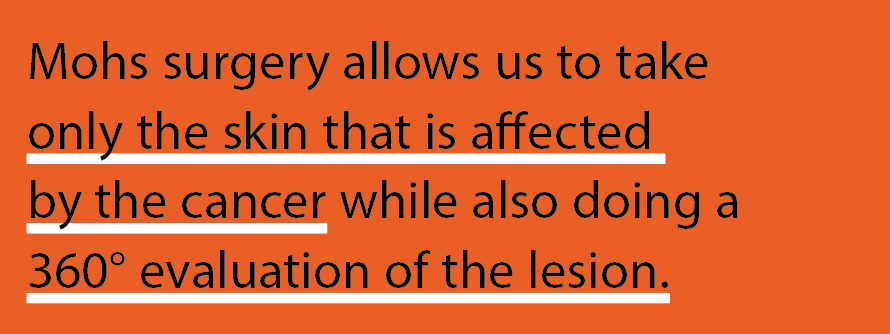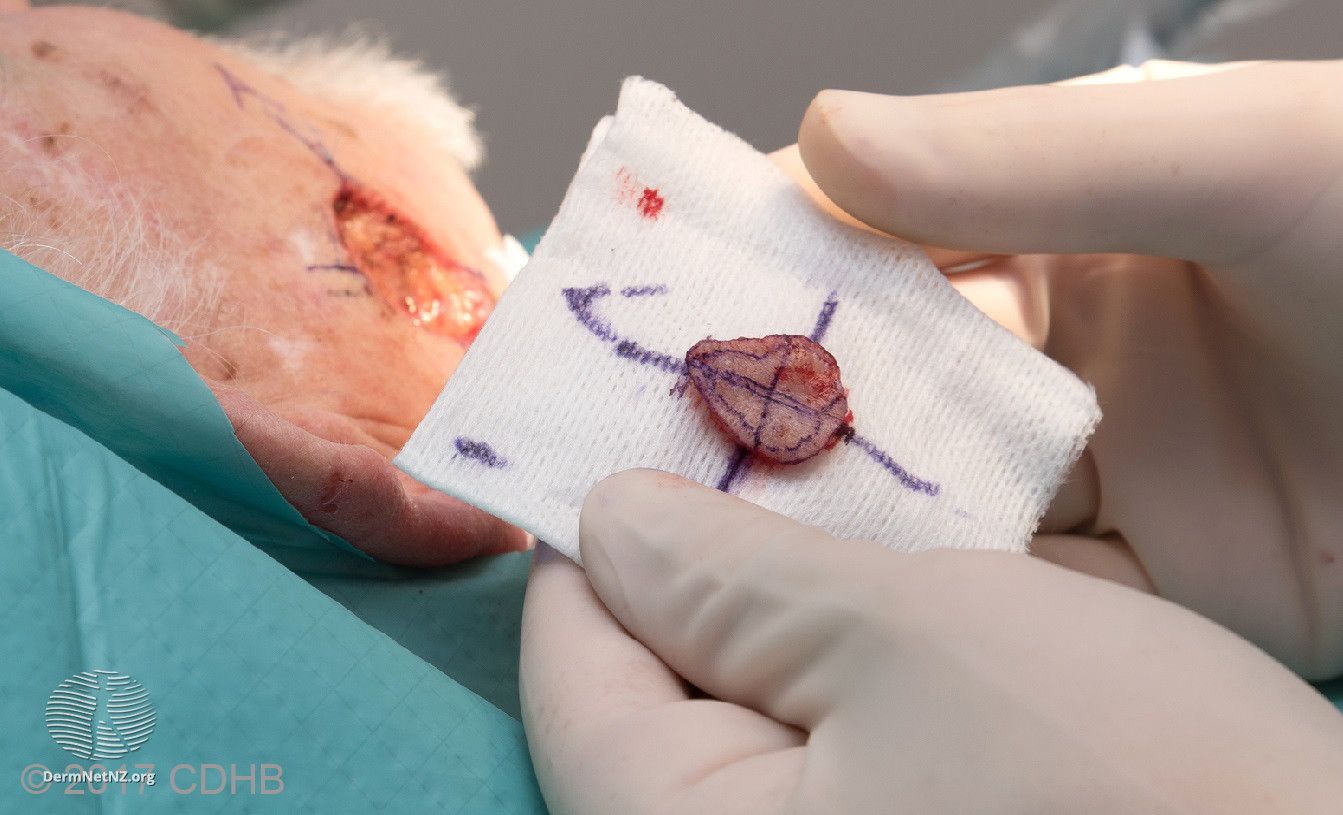- General Dermatology
- Eczema
- Alopecia
- Aesthetics
- Vitiligo
- COVID-19
- Actinic Keratosis
- Precision Medicine and Biologics
- Rare Disease
- Wound Care
- Rosacea
- Psoriasis
- Psoriatic Arthritis
- Atopic Dermatitis
- Melasma
- NP and PA
- Skin Cancer
- Hidradenitis Suppurativa
- Drug Watch
- Pigmentary Disorders
- Acne
- Pediatric Dermatology
- Practice Management
Advocating for Mohs Surgery in Prison Populations
From our March cover feature: Vulnerable populations such as the prison population should have access to Mohs surgery to prevent the increased risk of morbidity and mortality from skin cancer.
A 50-year-old man had a new lesion on his right upper eyelid that began to slowly grow. He noticed it and contacted his nearest health care facility. After he saw an ophthalmologist for a supposed skin tag, the biopsy returned as basal cell skin cancer. He came to the office apprehensive about receiving Mohs surgery. During the procedure he did not turn to his family or friends for support, but rather to the prison guards who had accompanied him from prison.
With millions of new cases being diagnosed each year, skin cancer is one of the most common types of cancer in the world. It is important for patients, including vulnerable populations, to have access to a dermatologist for early detection and treatment of skin cancers. Research has shown that prison populations have similar skin diseases affecting them as much as the general population.1,2 Mohs surgery is an extremely effective treatment for skin cancers. Vulnerable populations such as the prison population should have access to Mohs surgery to prevent the increased risk of morbidity and mortality from skin cancer. Research shows that patients in prison likely have an increased mortality risk because they have an average delay of treatment time greater than 30 days after the initial biopsy.2
Barriers to Dermatologic Care in the Prison Population
The nation with the highest incarceration rate is the United States.3 At a higher proportion, inmates tend to be racial and ethnic minorities, of low socioeconomic status, and young men. Incarcerated patients also tend to have higher rates of chronic diseases.4 Before incarceration, these patients frequently live in areas characterized by high levels of racial segregation, poverty, and unemployment.
There are various barriers that cause the inmate population to have an increased risk of skin cancer. Outdoor activities at a prison facility may be one way individuals get to work, improve their mental health with outdoor exposure, or exercise during the day.5 Extended exposure to sunlight without appropriate sunscreen or sun protective clothes can increase the risk of skin cancer. While in outdoor spaces, patients in prison may have decreased access to sunscreen. They may not be able to apply it every 2 hours or after sweating as recommended for optimal protection.
Patients in prison may not have access to public health campaigns and programs focused on health education and skin cancer prevention. They may not know about the different measures they can take for sun protection while incarcerated. At our practice, I have encountered multiple cases where patients had a lesion of concern but had issues gaining access to health care services while imprisoned, leading to delays in medical treatment and diagnosis. There is also a higher prevalence of mental health conditions and history of substance abuse that may affect patient understanding and the willingness to seek treatment for skin cancer.
Patients must attend appointments with prison guards when they leave the penitentiary. They are escorted by prison guards into their clinic appointments. The inmate loses privacy and must always remain with the prison guards. Given this lack of privacy, some patients may be less likely to report a lesion concerning for skin cancer if it is in an area such as the groin, breasts, or buttocks. One of the greatest barriers for health care in the prison population is scheduling appropriate follow-up care. Because these patients are incarcerated, it is recommended that providers do not tell inmates a specific date for a follow-up appointment. This ensures that they cannot plan or premeditate a time to escape prison during that appointment. The lack of clear and defined follow-up appointments is a challenge for providing continued follow-up care, making it difficult to schedule long-term appointments, maintain monitoring and management, and have surveillance of any concerning lesions on the skin.
Overall, the inmate population is at an increased risk for skin cancer due to causes such as decreased screening rates, risk factor prevalence, limited health care access, and limited transportation. For the prison population, it is difficult to access dermatologic care and patients have delays in getting in to see a dermatologist. There are complex systemic and behavioral factors that lead to the increased risk of skin cancer in the prison population. It is important to provide Mohs surgery accessibility for inmates. This highly specialized surgery can contribute to improved health outcomes for this vulnerable population.
The Need for Mohs Surgery in the Prison Population

Mohs surgery should be offered to patients in the prison population who have been diagnosed with skin cancers that fit the appropriate use criteria for Mohs. Reasons for Mohs include the following:
High cure rates and low recurrence: Mohs surgery is the gold standard for treatment of basal cell and squamous cell carcinomas. It is reported to have a cure rate of over 99% and one of the lowest recurrence rates for surgical treatment.6 This makes Mohs as a treatment modality crucial for the prison population because the patient’s access to health care is so limited. The effectiveness and efficiency of Mohs can help to decrease the need for future treatments, such as repeat excision.
Preservation of healthy skin: One of the goals of Mohs surgery is to diminish the margin of healthy skin removed during surgery in cosmetically sensitive areas such as the feet, face, and scalp. This allows us to take only the skin that is affected by the cancer while also doing a 360° evaluation of the lesion. This modality helps to improve cosmetic outcomes for the patient population and potentially improve their quality of life. This is especially important for patients who may already have mental health issues as a more cosmetic outcome can potentially decrease the risk of disrupting the patient’s self-image.
Cost-effective: As mentioned before, employing Mohs surgery helps to reduce the need for additional surgeries. This is also true if there is a concern for recurrence or high-risk pathology in areas where tissue conservation is needed. Mohs surgery ensures that the patient’s site is clear of tumor prior to repairing the patient. The effectiveness of Mohs surgery decreases the need for other treatments or surgeries. In the long run, this helps the prison and medical systems to decrease costs and maximize savings.
Conclusion
Patients in the prison system need access to Mohs surgery. Mohs can significantly improve outcomes for incarcerated patients diagnosed with skin cancer. According to the American Cancer Society, skin cancer is more prevalent than breast, lung, colon, and prostate cancers combined.7 These patients need effective treatment, early detection, tissue conservation, and improved health outcomes. Also, it is beneficial for the prison health care system to see the value of Mohs surgery and recognize the overall cost savings.
Prison systems can work with local Mohs surgeons to collaborate for treatment and increased healthcare access. At our practice, we were able to perform Mohs surgery for the 50-year-old man with the skin cancer on the eyelid previously mentioned. He was brought into the Mohs suite, went 2 stages, and had subsequent eyelid repair with oculoplastics coordination. He had never heard of Mohs surgery prior to his diagnosis of skin cancer. He has not had a recurrence and has full function and aesthetic restoration of his eyelid. Patients who are diagnosed with a skin cancer should have Mohs surgery presented as an available treatment option. Mohs surgery in the prison population is a first-line necessity for skin cancer treatment.
Nicole A. Negbenebor, MD

Nicole A. Negbenebor, MD, is a Mohs micrographic surgery and cutaneous oncology fellow in the Department of Dermatology at the University of Iowa in Iowa City.
References
1. Coury C, Kelly B. Prison dermatology: experience in the Texas Department of Criminal Justice dermatology clinic. J Correct Health Care. 2012;18(4):302-308. doi:10.1177/1078345812456365
2. Swigert A, Majidian M, Chen L, Vick G, Murina A. Skin cancer in the incarcerated population-a single-center study. Dermatol Surg. 2022;48(1):17-20. doi:10.1097/DSS.0000000000003247
3. Kaeble D, Glaze L. Correctional populations in the United States, 2015. US Department of Justice. December 2016. Accessed February 2024. https://bjs.ojp.gov/content/pub/pdf/cpus15.pdf
4. Davis DM, Bello JK, Rottnek F. Care of incarcerated patients. Am Fam Physician. 2018;98(10):577-583.
5. Morris NP, Izenberg JM. Mental health and legal implications of access to the outdoors during incarceration. J Am Acad Psychiatry Law. 2023;51(1):103-111. doi:10.29158/JAAPL.220061-22
6. Stanciu A, Florica CE, Zota A, Tebeica T, Leventer M, Bobirca F. Surgical outcomes of more than 1300 cases of Mohs micrographic surgeries from a private Mohs clinic in Romania. Chirurgia (Bucur). 2020;115(1):69-79. doi:10.21614/chirurgia.115.1.69
7. Skin cancer facts & statistics. Skin Cancer Foundation. Accessed February 6, 2024. https://www.skincancer.org/skin-cancer-information/skin-cancer-facts/


